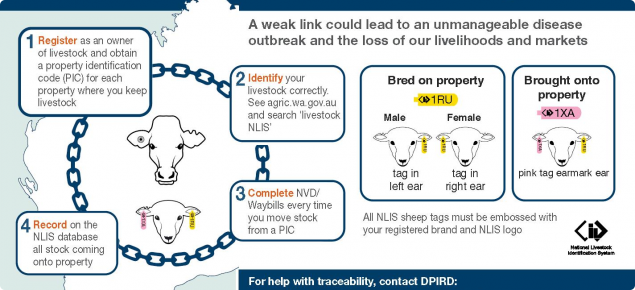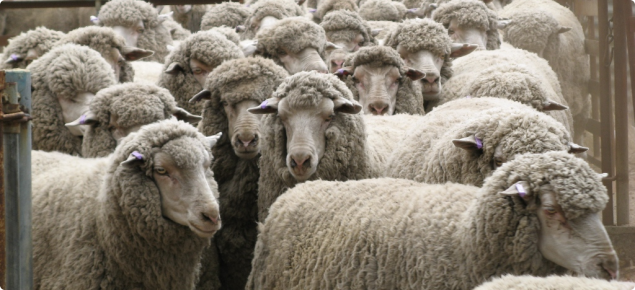Traceability
Stock traceability is the first step in good biosecurity and is a key part of everyday sound farm management practices. Traceability is essential for disease management, food safety and to maintain access to export markets. It allows stock to be traced for residue purposes and deters stock theft.
The Department of Primary Industries and Regional Development (DPIRD) assists owners to comply with the Biosecurity and Agriculture Management (Identification and Movement of Stock and Apiaries) Regulations 2013 [the BAM (IMSA) regulations]. If you are an owner of livestock, you have a responsibility to ensure that you meet these requirements.
Step 1: Register as an owner of livestock and obtain a property identification code (PIC) for each property where you keep livestock
DPIRD’s Brands Office processes registrations of ownership and allocates a property identification code (PIC) to indicate who owns the animals and where they are kept. A PIC card is issued that lists the properties where the owner has nominated to run stock and lists the registered identifiers for use with their stock, namely a stock brand, earmark and/or pig tattoo.
All registered owners, PICs and stock brands in WA are recorded in the Stock Brand and PIC Register. The Stock Brand and PIC Register search guide provides help on how to search the register and look for available stock brands.
There are now two avenues to register: via the new online Brands Portal or with the existing paper-based applications. If you are unable or prefer not to use the Brands Portal, you can download and send in the completed paper forms via email or post.
Register using the Brands Portal
The Brands Portal is a secure website that allows Beekeepers, Livestock owners and supply chain location operators to manage their registrations online. It is the preferred option for submitting registrations, re-registrations, updating property and contact details and for beekeepers to pay APC fees. The benefits of the portal include a reduction in the use of paper forms and associated manual procedures, automated correspondence and improved data management capabilities.
Log in to the Brands Portal to manage the following applications:
- New Livestock Owner Registration
- New Beekeeper Registration
- New Buyer Identification Code Registration
- New Non-Farming Property Operator Registration
- Update trading name, contact and property details on an existing registration
- Re-registration for Livestock Owner, Beekeeper, Non-farming PIC (NFOP) operator and Buyer Identification Code (BIC) operator
- Beekeeper APC Payments
You will be taken to the Welcome page of the Brands Portal where you will find information to guide you through the Digital Identity setup and Brands Portal login procedures.
Note: for Transfers, Cancellations and Notification of a mortgage over stock or apiary and/or withdrawal of that notification, you will need to continue to use the current manual paper forms.
Please see further information on using manual forms below.
Register using manual forms
Return the form with the appropriate fee by one of the following methods:
- Scan and email with credit card details to brands.bunbury@dpird.wa.gov.au
- Lodge the form and make payment at a DPIRD office. (Contact the Brands Office Excluding public holiday Monday to Friday 8.30am-4.30pm AWST on 1300 926 547 for locations that will take payment.
Or,
- Post the completed form with payment to:
Department of Primary Industries and Regional Development
Attention: Registrar of Stock and Apiaries - Brands Office
PO Box 1231
Bunbury WA 6231
Cheques are to be made payable to the Department of Primary Industries and Regional Development.
Note: including your email address and mobile phone number on your application improves automatic communication.
Who needs to register?
Owners of cattle, sheep, goats, pigs, horses, donkeys and hybrids, deer, alpaca, llama, camels, vicuna, buffalo; emu, ostrich and poultry (including chickens, turkeys, geese, ducks, guinea fowl, quails, pigeons, pheasants and partridges) depending on number of birds, need to register, even if these animals are kept as pets. Beekeepers are also required to be registered.
The requirement for poultry owners with 50 or more birds or owners of 10 or more emus and/or ostriches to register came into effect on 1 April 2022. Existing registered owners of livestock are encouraged to update their details with the Brands Office at their next renewal to indicate if they also run poultry, emus or ostriches. Owners with fewer birds can choose to register or not.
You can read further information on the Registering as an owner of stock or as a beekeeper at the Registration webpage. This webpage also describes how to register as a manager of a non-farming property (e.g. commercial feedlot, transit depot, showground, vet clinic) and to transfer, cancel or update property, address and trading details of existing registrations and identifiers.
Step 2: Identify your livestock correctly
Identification of livestock is required by law and assists in providing traceability as they move from property to property.
There are various stock identifiers available and livestock species have different identification requirements.
Livestock identification requirements by species
| Species | Identification requirements |
|---|---|
| Cattle and buffalo | Must have an NLIS electronic device and may have a registered identifier (brand and/or earmark). |
| Sheep | Must have an NLIS tag with either the brand or PIC of the owner displayed and may have a registered identifier (earmark). |
| Horses, donkeys and hybrids | Must have a registered identifier (brand) or an approved identifier (e.g. microchip) or breed society identifier. |
| Pigs | Must have a registered identifier as a tattoo or an NLIS tag with the PIC of the current owner displayed, prior to being moved. Pigs under 25kg can only be tagged. Pigs 25kg+ can be either tagged or tattooed. |
| Goats | Must have an NLIS tag with either the brand or PIC displayed and may have a registered identifier (earmark). |
| Deer, alpaca, llama and vicuna | Must have a registered identifier (brand and/or earmark) or an approved identifier. |
| Camels | Not required to be identified unless the owners wish to identify, claim ownership or distinguish from feral populations or camels owned by another party. |
| Poultry (including chickens, turkeys, geese, ducks, guinea fowl, quails, pigeons, pheasants and partridges) | Not required to be identified but owners with 50 or more birds need to register as an owner of livestock. |
| Emus and ostriches | Not required to be identified but owners of 10 or more emus and/or ostriches need to register as an owner of livestock. |
Full details of identification requirements including application methods and age timeframes are available via each species page link.
Types of stock identifiers
| Stock identifier type | Description of stock identifier type |
|---|---|
| Registered identifiers | Stock brand, earmark or tattoo to be applied according to species, age and placement requirements.
DPIRD’s Brands Office issues registered identifiers at registration. |
| Approved identifiers | A preferred type of identification system (such as a brand, microchip or brass tag) for recognised breed societies which may be approved after application to the Registrar of Stock and Apiaries.
Approved identifiers replace registered identifiers, but not NLIS identification. |
| National Livestock Identification System (NLIS) identifiers | The NLIS is a permanent, whole-of-life identification system for cattle, sheep, goats, pigs and buffalo that enables animals to be tracked from property of birth to slaughter or export.
NLIS identification and tracing requirements differ according to the species. |
For more information email nlis@dpird.wa.gov.au or call 1300 NLIS (1300 926 547).
Earmarking and branding of sheep and cattle in WA is optional from 1 January 2022
Following consultation with WA sheep and cattle owners and industry stakeholders, the earmarking of sheep and earmarking and/or branding of cattle is now optional.
If owners wish to earmark their sheep or earmark and/or brand their cattle, they may do so. It is no longer non-compliant not to.
Step 3: Complete a movement document every time you move stock off a property
Whenever livestock are moved off a property, livestock movement documentation such as a waybill, national vendor declaration (NVD)/waybill, Pigpass NVD/waybill or equivalent is required for most species.
This includes stock being moved to agistment or to a different PIC under the same ownership.
Documentation required when moving livestock off a property
| Species | Requirements when moved off a property |
|---|---|
| Cattle Sheep Goats Buffalo | NVD/waybill or waybill. If moving to a different PIC, the movement must be recorded in the national NLIS database within 48 hours of arrival. |
| Pigs | Waybill or PigPass NVD/waybill. If to a different PIC, the movement must be recorded on the PigPass database, which automatically updates the NLIS database. |
| Deer, alpaca, llama or vicuna | Waybill or equivalent movement document. |
| Horses, donkeys and hybrids camels |
Do not require waybill or equivalent movement document unless being moved to an abattoir for slaughter for human consumption.
|
| Poultry (including chickens, turkeys, geese, ducks, guinea fowl, quails, pigeons, pheasants and partridges)
| Do not require waybill or equivalent movement document. |
| Emu and ostrich | Do not require waybill or equivalent movement document. |
A waybill is not required when moving stock between properties with the same PIC, if the stock are accompanied by your current PIC card or a full copy of it (showing both sides) which lists the properties registered to that PIC. Stock being moved need to be identified and if cattle, sheep, goats, pigs or buffalo, must be registered to that PIC.
Step 4: Record on the NLIS database all stock coming onto a property
When you bring in cattle, sheep, goats or buffalo you are responsible for updating the NLIS database.
If you buy through an agent always ask if they are doing the transfer for you and request the NLIS upload number – it is your receipt to prove the transfer is done.
If you buy in pigs, you must be record this on the PigPass database, which automatically updates the NLIS database.
Beekeepers
Beekeepers have a requirement to identify their hives with their brand and maintain records of where and when the hives are kept.
Livestock movement into and out of WA and the Kimberley region
There are controls and movement recording requirements for all livestock entering and leaving WA and also across disease control lines, such as the tick line in the Kimberley.
For information on importing livestock from overseas and other Australian states and territories see Importing livestock into WA and for intrastate see Moving livestock in Western Australia.
For information relating to livestock movement to other Australian states and territories, please consult with the importing state.
Report suspicious activities
Please report suspicious activities such as the illegal importation or sale of illegal animals or plants, or the keeping of exotic animals or birds to AgWatch for further investigation.



